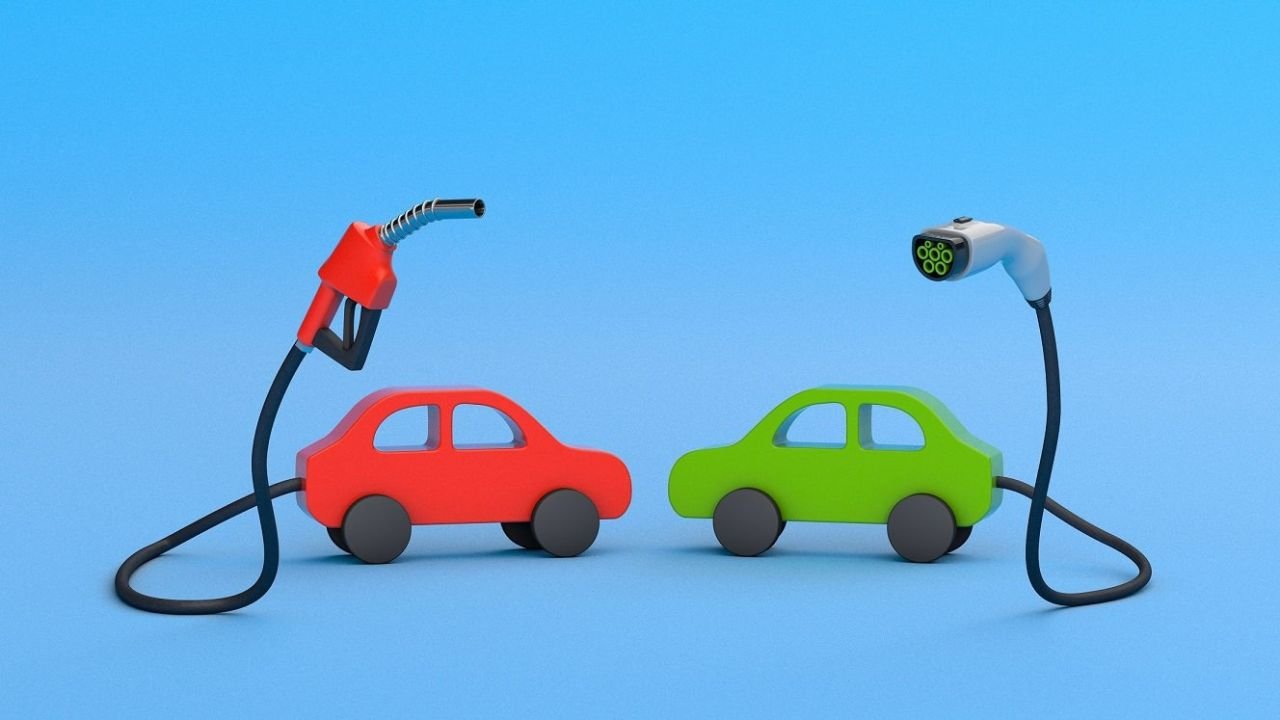Curious about switching to an electric vehicle? You’re certainly not alone. With the rise of environmental consciousness, advancements in technology, and the surging costs of fuel, electric vehicles (EVs) are becoming ever more popular. The journey to making the switch involves assessing numerous pros and cons that will impact your decision. This blog post will guide you through the multifaceted discussion on the advantages and potential drawbacks of EVs, helping you determine if making the switch is the right move for you. Keep reading to uncover the hidden truths and essential facts to make an informed decision about switching to an electric vehicle.
Environmental Impact
When we think about switching to an electric vehicle, the environmental impact is one of the most important factors to consider. EVs help in creating a cleaner, healthier environment compared to traditional internal combustion engine (ICE) vehicles.
Reduced Greenhouse Gas Emissions
Electric vehicles contribute significantly to reducing greenhouse gas emissions. Unlike ICE vehicles that burn fossil fuels and emit carbon dioxide (CO2), EVs run on electricity and have zero tailpipe emissions. This means that over their lifetime, EVs produce fewer emissions even when accounting for the emissions from electricity production.
- Comparison with ICE Vehicles: A typical gasoline vehicle emits about 4.6 metric tons of CO2 per year. In contrast, EVs, especially those powered by renewable energy sources, can reduce these emissions drastically. According to studies, electric vehicles produce about 50% fewer greenhouse gas emissions compared to gasoline-powered vehicles.
- Lifecycle Emissions: It’s important to note that manufacturing EVs, particularly their batteries, initially involves more emissions. However, the overall emissions over the entire lifecycle of an EV, including production, operation, and disposal, are still much lower compared to ICE vehicles.
Decreased Air Pollution
One of the biggest advantages of EVs is their contribution to decreased air pollution. Unlike ICE vehicles that release pollutants such as nitrogen oxides (NOx) and particulate matter (PM) into the air, EVs do not emit exhaust gases. This leads to significant improvements in air quality, especially in urban areas.
- Better Air Quality: Cities that have a higher number of EVs on the road report improved air quality. This is crucial in areas where smog and pollution are rampant. Cleaner air means healthier living conditions, reducing respiratory issues and other health problems.
- Noise Pollution: Along with reducing air pollution, EVs also help in reducing noise pollution. They operate much more quietly than traditional vehicles, contributing to a reduction in noise, which is beneficial for city environments.
Reducing pollution not just benefits the planet but also leads to healthier communities. With zero-emission vehicles, cleaner cities can become a reality, making the switch to an EV an essential step towards a sustainable future.
By choosing an electric vehicle, you are not just making a smart economic choice but also contributing significantly towards a cleaner, healthier environment. The reduced greenhouse gas emissions and decreased air pollution are compelling reasons to consider switching to an electric vehicle.
For more detailed information on the environmental benefits of EVs, you can check out Electric Vehicle Myths and How Green Are Electric Vehicles?.
Cost Considerations
When contemplating the switch to an electric vehicle (EV), one of the key aspects to evaluate is the cost. From the initial purchase price to ongoing expenses like maintenance and fuel, understanding the financial implications is crucial.
Initial Purchase Price
Switching to an electric vehicle comes with a higher upfront cost compared to traditional internal combustion engine (ICE) vehicles. The average cost of a new EV is steep, often starting around $30,000 and reaching up to $100,000 for high-end models like Tesla and BMW.
However, several government incentives and tax credits can help offset these costs. Many countries and states offer rebates and perks to encourage EV adoption. For instance, in the U.S., federal tax credits for EVs can be as high as $7,500, depending on the model and battery capacity. Here’s a detailed breakdown of available incentives that might help you save money on your initial purchase.
Maintenance and Repairs
Electric vehicles generally have fewer moving parts than traditional cars. This translates to lower maintenance and repair costs over time. Since EVs don’t have engines, they eliminate several routine services required by ICE vehicles, such as oil changes, fuel filter replacements, and spark plug checks.
According to a report by AAA, EV owners spend about $330 less per year on maintenance compared to those with gas-powered cars. This lower maintenance cost is primarily due to the absence of a conventional engine and fewer mechanical components that can wear out or fail. More on the true cost of maintenance can be found in AAA’s comprehensive study.
Fuel Costs
One of the most compelling financial benefits of switching to an electric vehicle is the reduced fuel cost. Charging an EV is significantly cheaper than refueling a gas-powered car. On average, powering an EV costs about $500 per year, while gasoline costs for ICE vehicles can average $1,000 to $2,500 annually.
EVs can be charged at home using a standard electric outlet or more efficiently with a dedicated EV charger. Public charging stations are also becoming more common, some of which offer free charging as a part of government or corporate initiatives.
Comparative Fuel Costs:
- Electricity: EVs typically cost around $0.03 per mile to charge.
- Gasoline: Traditional vehicles average about $0.10 to $0.15 per mile in fuel costs.
The financial impact of switching to an EV includes multiple factors such as the higher initial purchase price, lower maintenance expenses, and significantly reduced fuel costs. These considerations are essential for anyone thinking of making the switch to an electric vehicle. For an in-depth comparison of these costs, visit this comprehensive guide by NRDC.
References
- Electric Vehicle Benefits and Considerations
- True Cost of Electric Vehicles | AAA Automotive
- Electric vs. Gas Cars: Is It Cheaper to Drive an EV?
Thinking about these cost factors helps paint a clearer picture of what to expect financially when switching to an electric vehicle.
Performance and Driving Experience
When it comes to the performance and driving experience of electric vehicles (EVs), these modern marvels offer unique advantages that you simply can’t find in traditional cars.
Acceleration and Handling
One of the most exciting aspects of driving an EV is the instant torque. Unlike gas-powered engines that need time to build up speed, electric motors deliver swift and smooth acceleration from the moment you press the pedal. This results in:
- Quick starts: EVs can accelerate from 0 to 60 mph in just a few seconds, making them highly responsive.
- Smooth acceleration: You’ll experience a seamless ride without the jerks and pauses typical of gear changes in conventional vehicles.
Additionally, EVs are known for their excellent handling. With the battery pack placed at the bottom of the car, they have a lower center of gravity, which makes them more stable and better at cornering. This translates to a more enjoyable and confident driving experience.
Noise Levels
Another striking feature of electric vehicles is their significantly quieter operation. Traditional combustion engines are noisy, emitting sounds that can be tiring during long drives or in busy traffic. In contrast, EVs operate with minimal noise, offering several benefits:
- Reduced Stress: The quiet ride can make your journey more peaceful and less stressful.
- Better communication: Without the roar of an engine, it’s easier to hold conversations inside the car.
- Environmental impact: Quieter vehicles contribute to reduced noise pollution, benefiting urban areas and residential communities.
It’s like driving in a peaceful bubble, where you can appreciate the sounds of nature and the subtle noises of the road. EVs provide a driving experience that’s not just about getting from point A to point B, but about enjoying the journey in between.
 Photo by Gustavo Fring
Photo by Gustavo Fring
Range and Charging Infrastructure
When considering switching to an electric vehicle (EV), one important aspect is understanding the range and the charging infrastructure available. This section will help you get a clear picture of what to expect regarding range, how long it takes to charge, and the availability of charging stations.
Driving Range
The driving range of modern electric vehicles is quite impressive. Most EVs on the market today offer a range from 150 to over 300 miles on a single charge, enough for daily commutes and even most road trips. However, several factors can affect this range:
- Battery Capacity: Larger batteries provide more range. High-capacity batteries are common in models like the Tesla Model S and the Lucid Air.
- Driving Habits: Aggressive acceleration and high speeds can reduce range. Gentle driving helps conserve energy.
- Weather Conditions: Cold weather can decrease battery efficiency, thus reducing range.
- Load and Use: Carrying heavy loads and running multiple electronic devices can impact how far you can travel on a charge.
For perspective, consider charging infrastructure improvements highlighted by the International Energy Agency.
Charging Time
Charging an EV isn’t quite the same as fueling a conventional car with gasoline. There are different types of charging, each with varying time requirements:
- Level 1 Charging:
- Uses a standard household outlet (120 volts).
- Slowest option, adding about 2-5 miles of range per hour.
- Best suited for overnight charging at home.
- Level 2 Charging:
- Requires a special charging unit (240 volts).
- Much faster, adding about 10-20 miles per hour.
- Commonly found at public charging stations, workplaces, and residential areas.
- DC Fast Charging:
- Provides a rapid charge by using direct current, bypassing the car’s onboard charger.
- Can add up to 80% of the battery’s capacity in 30 minutes.
- Mostly available at dedicated fast-charging stations along highways and major routes.
These options give flexibility depending on your needs and availability of charging infrastructure. Explore the HYLAN blog for deeper insights into advancements in EV charging.
Availability of Charging Stations
As EV adoption grows, so does the charging infrastructure. The number of charging stations is rapidly increasing worldwide, making long-distance travel more feasible with an electric vehicle:
- Growth Trends: The number of EV charging stations has seen a substantial rise, with public ports increasing by 8.4% in recent years. This growth is crucial for supporting the wider adoption of EVs.
- Strategic Locations: Charging stations are now strategically located in urban areas, shopping centers, and major highways, ensuring that EV drivers have ample options when they need to recharge.
- Government Support: Many governments are investing heavily in infrastructure to promote electric vehicles, including substantial incentives and funding for public charging stations.
The expansion in charging infrastructure not only makes owning an EV more convenient but also addresses common concerns about the availability of charging options. Learn more about how charging infrastructure is evolving from this Electric Vehicle Charging Infrastructure Trends.
The strides in driving range and charging infrastructure are making electric vehicles increasingly practical for everyday use, town trips, and long-distance travel.
Technological Innovations
As the electric vehicle (EV) industry continues to evolve, technological innovations play a pivotal role in shaping the future of transportation. Let’s delve into two key areas where advancements are revolutionizing the driving experience.
Battery Technology
Battery technology stands at the forefront of EV innovation, driving improvements in range, efficiency, and charging times. The evolution of lithium-ion batteries has been instrumental in enhancing the performance of electric vehicles.
- Enhanced Range: Modern EVs are equipped with high-capacity batteries that offer extended driving ranges, allowing drivers to cover more miles on a single charge. Innovations in battery chemistry and design have significantly increased the energy density, providing a longer driving range without compromising performance.
- Reduced Charging Times: Rapid advancements in fast-charging technology have addressed one of the primary concerns of EV owners – charging speed. With the introduction of fast chargers and high-power charging stations, drivers can replenish their battery levels quickly, making long journeys more convenient and accessible.
For a deeper understanding of the latest breakthroughs in battery technology for electric vehicles, explore insights from Battery University.
Smart Features
The integration of smart features in electric vehicles has transformed the way we interact with our cars, enhancing convenience, safety, and overall driving experience. Let’s explore some of the cutting-edge smart features available in modern EVs:
- Regenerative Braking: EVs utilize regenerative braking technology to convert kinetic energy into electrical energy, which is then stored in the battery. This not only improves energy efficiency but also extends the driving range of the vehicle.
- Autonomous Driving Capabilities: Many electric vehicles come equipped with advanced driver-assist systems that enable semi-autonomous driving. Features like adaptive cruise control, lane-keeping assist, and automatic parking enhance safety and reduce driver fatigue during long journeys.
- Over-the-Air Updates: EV manufacturers regularly release software updates that can be wirelessly downloaded to the vehicle, enhancing performance, adding new features, and addressing any potential issues. This seamless update process ensures that EVs stay up-to-date with the latest technology advancements.
By incorporating these smart features, electric vehicles are not just modes of transportation but sophisticated pieces of technology that offer a glimpse into the future of mobility.
Stay tuned for more insights on the technological advancements shaping the electric vehicle industry and how they are influencing the driving experience.
Consumer Considerations
When contemplating the switch to an electric vehicle (EV), several crucial factors come into play, influencing the decision-making process for potential buyers. Understanding how lifestyle choices, resale value, and other consumer considerations impact the suitability of EVs is essential for making an informed choice.
Lifestyle and Driving Habits
The lifestyle and daily driving habits of individuals play a significant role in determining the suitability of electric vehicles. Consider how your routine aligns with the capabilities of an EV:
- Commute Distance: If you have a long daily commute, ensuring that the EV’s range can comfortably cover your travel distance without frequent recharging is vital.
- Charging Accessibility: Evaluate the availability of charging stations along your regular routes and at your residence to ensure convenient charging options.
- Travel Patterns: Assess your travel patterns to determine if an EV’s range meets your needs, especially if you frequently embark on long road trips.
Understanding how your lifestyle and driving habits align with the capabilities of electric vehicles is crucial for a seamless transition to sustainable transportation. Explore more insights on lifestyle considerations from EV Life.
Resale Value
The resale value of electric vehicles compared to traditional vehicles is a key consideration for potential buyers. Factors that influence the resale value of EVs include:
- Battery Health: The condition and remaining capacity of the battery pack significantly impact the resale value of an EV. Buyers often consider the battery’s health as a crucial factor in determining the vehicle’s worth.
- Technological Advancements: Rapid advancements in EV technology can affect the resale value of older models. Buyers may prefer vehicles with the latest features and improvements.
- Market Demand: The overall demand for electric vehicles in the resale market plays a role in determining the value of pre-owned EVs. Understanding market trends and consumer preferences is essential for gauging resale potential.
Considering the resale value of electric vehicles in comparison to traditional vehicles provides insight into the long-term financial implications of switching to an EV. For a detailed analysis of EV resale trends, refer to Electric Vehicle Resale Value Guide.
References
Exploring lifestyle factors and understanding the resale value dynamics of electric vehicles are essential steps in the decision-making process for potential EV buyers.
Future Outlook
As we look ahead, the future of electric vehicles (EVs) is both promising and dynamic. The landscape is poised for significant changes driven by market growth and government policies.
Market Growth
The electric vehicle market is on the brink of substantial growth. According to recent forecasts, the sales of electric cars could comprise up to 20% of new car sales by 2025, and even reach 40% by 2030. Several factors are fueling this anticipated growth:
- Declining Battery Costs: Advances in battery technology are driving down costs, making EVs more affordable. This trend is crucial for mass adoption, as more consumers find electric cars an economic alternative to gas-powered vehicles.
- Improved Range: Modern EVs now offer ranges upwards of 300 miles per charge, alleviating “range anxiety.” With extended range capabilities, electric cars are becoming a practical choice for a broader audience.
- Infrastructure Expansion: The expansion of charging infrastructure globally is making it easier for EV owners to find charging stations. This includes fast-charging networks along major highways, which facilitate long-distance travel.
- Consumer Awareness and Demand: Growing awareness of environmental issues and the desire for sustainable living are prompting more consumers to consider EVs. People are increasingly valuing the long-term benefits of zero-emission vehicles.
These elements collectively contribute to a robust market outlook for electric vehicles. For more insights on market trends, visit EV Market Trends.
Government Policies
Government policies play a pivotal role in accelerating the adoption of electric vehicles. Various regulations and incentives are being implemented worldwide, making it increasingly attractive to make the switch to an EV.
- Subsidies and Tax Incentives: Governments are offering substantial subsidies and tax credits to lower the effective cost of purchasing an EV. For example, the U.S. federal tax credit can reduce the cost by several thousand dollars, and many states offer additional incentives.
- Regulatory Mandates: Several countries have set ambitious targets for phasing out internal combustion engines (ICEs). For instance, Norway aims to end sales of new petrol and diesel cars by 2025, while the UK has set a 2030 target.
- Emission Standards: Stricter emission standards are pushing automotive manufacturers to invest more in EV technology. Regions like the European Union have stringent CO2 targets, creating a regulatory environment conducive to EV proliferation.
- Infrastructure Investment: Significant government investments are being directed towards building a more extensive and reliable charging infrastructure. This includes grants for public charging stations and support for home charger installations.
Government actions are essential for creating an environment that supports EV growth. They not only make electric vehicles more accessible financially but also ensure the necessary infrastructure is in place for wide-scale adoption. For a deeper understanding of how governmental policies shape the EV landscape, explore the IEA report on Electric Vehicles.
By staying informed on market trends and government policies, consumers can better understand the evolving landscape and make well-informed decisions about switching to electric vehicles.
Read More: How to Spot Fake Reviews on Amazon
Switching to an Electric Vehicle
Switching to an electric vehicle presents a compelling mix of benefits and challenges. The environmental advantages, such as reduced greenhouse gas emissions and improved air quality, make EVs a smart and eco-friendly choice. Additionally, the cost benefits from lower fuel expenses and minimal maintenance can lead to long-term savings.
However, higher initial purchase prices and concerns about driving range and charging infrastructure remain significant considerations. These factors may not align with everyone’s lifestyle and needs.
Ultimately, potential EV buyers should weigh these pros and cons based on their unique circumstances. To get a firsthand experience, consider further research or schedule a test drive with an electric vehicle model that interests you. Taking these steps will help determine if switching to an electric vehicle aligns with your personal and financial goals. Happy driving!






